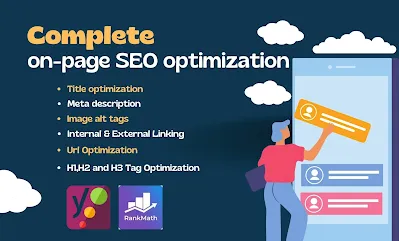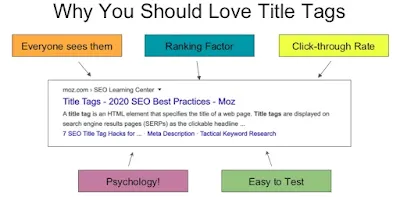On Page Optimization In SEO
On-Page Optimization
A snippet is a condensed summary of text from a webpage that appears in search engine results. Search engines show snippets, to give users an impression of the webpage before they click on the link. A URL, title, favicon, and meta description combine to create a mobile snippet.
There are two primary sections on a web page: the "head" area and the "body" portion.
The URL, page title, and meta description are contained in the "head" part of a webpage.
The actual content of the webpage that users can see is contained in the "body" section.
Head part
1. Title Optimization
The title tag is important for SEO because it's a brief summary of the information on the web pages. It is advantageous for users and search engines to understand clearly.
These are the guidelines for optimizing the title tag:
- The webpage's content should be appropriately described in the title tag.
- For your title to display effectively in the search result, aim for a title length of about 55–60 characters.
- Every webpage needs a unique title tag. Otherwise, In this situation, cannibalism would occur. Competition between web pages on a website for the same title is referred to as cannibalism.
- The highest visible character count in Google's search box is around 512 pixels.
- It must contain appropriate keywords.
- It is not acceptable to use complete small or capital letters.
- The title should contain at least three words.
Following these guidelines will help in producing efficient and optimized title tags. That increases a webpage's visibility in search engines and attracts more users.
2. Meta Description Optimization
The meta description is required to attract customers and raise click-through rates(CTR) from searches. Meta-description optimization involves developing brief and engaging descriptions for websites. The CTR metric measures the proportion of users who click on a particular link after viewing it.
Usually, between 155–160, characters should make up the meta description. In the meta description, the character limitation in the blog is 155.
The description will be free of technical or grammatical errors.
For each web page, a different meta description is required.
A 1024-pixel width is recommended for the meta description.
User impressions are made via attractive meta descriptions.
If no Meta descriptions are provided, Google will point out some of the contents of the website.
Robot meta tag: The HTML element known as the "meta robot" provides search engines with instructions on how to crawl and index a webpage's content.
Body part
1. Header tag
2. Content Optimization
With the use of content optimization, search engine crawlers can better understand and index web page content. It is used to raise the website's quality and visibility. Several processes are included in content optimization,
Choose the appropriate terms you expect your target audience to use in searches. It will make the information easier to understand for both Google and the user.
Apply Sub-headings and Clear Headings.
Include useful internal links to other pages on your website. The CTR (click-through rate) will go up, the bounce rate will go down, and Google will get more impressions.
Google can quickly crawl your website, by placing a keyword at the beginning of each article or paragraph.
The percentage of times a given word appears within a content as related to the total number of words count is known as keyword density.
What is keyword density?
The percentage of times a given word appears within a content as related to the total number of words count is known as keyword density. Keyword density doesn't promote ranking. However, Google advises that it's better to repeat the keyword a few times within the publish page.
3. Image Optimization
The entire user experience can be improved, and more impressions can be obtained by selecting appropriate images. Both the file name and the Alt text are included in image optimization. The file name must be matched to the image. When selecting the image, there are a few factors you must consider.
Using informative filenames and Alt text for the images can help search engines understand the context of the images
Use striking and powerful visuals.
When naming the file, hyphens should be used instead of spaces. Example,
<img src="img_bag.jpg" alt="bag"/>
4. Link Optimization
Link optimization is the process of making links on a website more user-friendly, navigable, and visible to search engines. Internal linking is the act of adding a link within a website to a particular page. These links increase the impressions of a website. An anchor text is the text that can be clicked on within a hyperlink.
For your internal links, make sure the anchor text (the content that appears in the anchor tag) is attractive and useful.
Linking inside a website encourages visitors to stay longer. It means the bounce rate will drop, but the impression will rise.
Our websites will be credible by providing links to reliable websites.
When websites include hyperlinks, users have a tendency to click, which boosts the popularity of the websites.







Những khái niệm cơ bản này dễ tiếp cận với tất cả mọi người, nhưng những ai mới bắt đầu SEO đừng nghĩ đây là những điều đơn giản, SEO dễ dàng, không, SEO 2024 với AI và các thuật toán cập nhật là một sự phức tạp. Không ai chắc chắn cả, hãy kiễn nhẫn là điều duy nhất cần giữ.
ReplyDeleteHòa VT: https://hoavt.com/
This comment has been removed by the author.
ReplyDelete